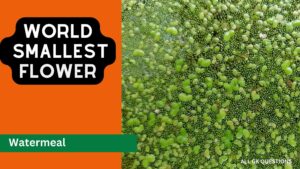Rafflesia Arnoldii is the largest flower in the world. In the lush rainforests of Southeast Asia, a botanical wonder reigns supreme – the Rafflesia arnoldii, commonly known as the largest flower in the world.

Table of Contents
Introduction
A biological marvel regarded as the largest flower in the world, Rafflesia Arnoldii, reigns dominant in the tropical jungles of Southeast Asia.
It is a parasitic plant that grows in the rainforests of Indonesia and Malaysia. It can produce a single bloom that can reach up to 4 feet (120 cm) in diameter and weigh up to 15 pounds (7 kg)34 It is also famous for its foul smell of decaying flesh, which attracts flies for pollination. In this article, we set out to investigate the details of this amazing flower behemoth, learning about its characteristics, natural environment, and mysteries.
How do we identify a Rafflesia Arnoldii flower?
A Rafflesia flower is a large, fleshy, reddish-brown structure with five lobes and white spots. It has a spiked disk in the center, which bears either male or female reproductive organs. It also emits a foul smell of rotting flesh to attract pollinators.
You can identify a Rafflesia flower by its size, shape, color, smell, and host plant. A Rafflesia flower can be as big as a meter or as small as 20 centimeters across, depending on the species It has a circular or oval shape, with thick, wavy lobes that resemble meat. It has a dark reddish-brown color, with white or yellow spots or blotches12 It has a strong, unpleasant smell of decaying flesh, which can be detected from a distance. It grows on the stems or roots of vines in the genus Tetrastigma, which are found in the rainforests of Southeast Asia.
Where is the Rafflesia arnoldii flower found in the world?
This amazing plant is indigenous to Southeast Asian jungles, which are found in nations like Indonesia, Malaysia, Thailand, and the Philippines. It grows well in warm, tropical areas where it is frequently obscured by the thick undergrowth of primary and secondary rainforests.
Rafflesia arnoldii flower found in India?
Unfortunately, you cannot see Rafflesia arnoldii in India, as it is native only to the rainforests of Sumatra and Borneo in Indonesia and Malaysia. However, other species of Rafflesia grow in India, such as Rafflesia canina and Rafflesia manillana, which are found in the Western Ghats of Kerala and Tamil Nadu. These species are also parasitic plants that produce large and smelly flowers, but they are smaller and less spectacular than Rafflesia arnoldii.

The lifespan of Rafflesia flower
A Rafflesia flower has a very short lifespan of only 5 to 7 days. This makes it difficult for pollination to occur, as the flower needs to synchronize its blooming with another flower of the same species and opposite sex.
Role of flies in pollinating Rafflesia Arnoldii Flower
The largest flower in the world, Rafflesia, is mostly pollinated by flies. Rafflesia gives off an unpleasant rotten flesh odor that draws carrion flies, who typically hunt for decomposing carcasses. The pollen that covers the flies when they enter the flower spreads to other flowers of the same species but of the opposite sex. Rafflesia tricks flies into pollinating its blooms instead of providing them with nectar or other rewards.
Conclusion
In the above article, we can know the name of the largest flower in the world, i.e. Rafflesia Arnoldii. This giant flower can be seen only in rainforests of southeast Asia. But it is famous for its foul smell, and having a dark reddish-brown color with yellow spots.
FAQs related to the largest flower in the world
Why does Rafflesia arnoldii emit a foul odor?
The foul odor emitted by Rafflesia arnoldii serves a vital purpose in its reproductive strategy. The scent, resembling that of a decaying animal, attracts carrion flies. These flies, drawn to the odor, become unwitting pollinators as they visit the flower in search of a suitable site to lay their eggs.
How long does the blooming period of Rafflesia arnoldii last?
The blooming period of Rafflesia arnoldii is notoriously short-lived, often lasting only a few days. This brief window is a critical phase for pollination to occur. After this period, the flower wilts, and the cycle begins anew when conditions are favorable for another bloom.
Are there different species of Rafflesia, or is Rafflesia arnoldii the only one?
Rafflesia is a genus that comprises various species, each with its unique characteristics. Rafflesia arnoldii is the most well-known and recognized species due to its status as the largest flower in the world. However, other species within the genus also exhibit fascinating features and are found in different regions of Southeast Asia.
What challenges does Rafflesia arnoldii face in terms of conservation?
Rafflesia arnoldii faces significant conservation challenges, primarily stemming from habitat loss due to deforestation and human activities. The flower’s reliance on specific host plants further exacerbates its vulnerability. Conservation efforts focus on preserving its natural habitat and raising awareness to mitigate these threats.
Can Rafflesia arnoldii be found in botanical gardens or cultivated environments?
While cultivating Rafflesia arnoldii outside its natural habitat is challenging, some botanical gardens and specialized facilities have attempted to showcase this extraordinary flower. However, successful cultivation remains rare due to the plant’s specific requirements, including the presence of its host plant and a suitable tropical environment.




Pingback: Best 50 All GK Questions with Answer for Class 2 - All GK Questions
Pingback: The Smallest Flower in the World! Watermeal (Wolffia globosa) - All GK Questions
Pingback: What is the Internet? Learn basic Facts and Uses
Pingback: World Sparrow Day 2024 Theme in India: Importance and History of Small Birds in the World